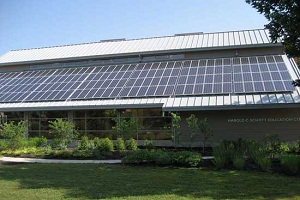Week in review: Obama nominates new energy chiefs, moving US forward in solar
 Last week President Obama nominated new heads for the Department of Energy and the Environmental Protection Agency, the two organizations that most impact the U.S.’s energy future. The solar industry must have seen that as a good thing because numerous companies announced they were moving forward with more funding or new research, or new projects aimed at bringing solar to more people.
Last week President Obama nominated new heads for the Department of Energy and the Environmental Protection Agency, the two organizations that most impact the U.S.’s energy future. The solar industry must have seen that as a good thing because numerous companies announced they were moving forward with more funding or new research, or new projects aimed at bringing solar to more people.
First off, President Obama announced his appointees to head the Energy Department and the EPA. To lead the Energy Department he nominated former Energy Department Undersecretary Ernest Moniz who now leads MIT’s Energy Initiative. To lead the EPA he appointed Gina McCarthy, the agency’s assistant administrator. Both appointees were praised by environmentalists and the clean energy industry.
Then another residential third-party ownership company announced a major new funding deal when OneRoof Energy announced a new fund of up to $100 million. The company partnered with Morgan Stanley MS Solar Holdings Inc. and Main Street Power and National Bank of Arizona. The bank is providing debt financing. Under the agreement OneRoof will use MS Solar’s and Main Street’s residential lease financing platform.
Meanwhile, Mosaic continued on its trend of popularizing solar crowdfunding projects. This time it partnered with Pristine Sun to fund six solar projects, totaling 6 megawatts. The offering will allow Mosaic to fund the projects through people’s individual investments rather than seek funding through bank or other investing institution. The projects also see an evolution of Mosaic’s offerings since it can now offer a return on investment on their projects.
Mosaic’s offering is another attempt to make solar more accessible to more people, which is still an issue, particularly in the U.S. A recent report from the Climate Policy Initiative found that policy and markets, continue to hinder more institutional investment in solar projects. That’s largely because some of the incentive programs, like the Investment Tax Credit require that the applicant is a taxed organization, while many pensions or other institutional investors are non-profits that aren’t taxed. If that changes it could potentially open up a new reservoir of funding for solar, upwards of $71 trillion in financing across the world.
But bringing the cost of solar down, particularly for homeowners, could be largely achieved by reducing the soft costs of solar (i.e., permitting, lawyer fees and other paperwork). A new white paper from Solar Freedom Now contended that streamlining the process to reduce such fees could halve the costs of rooftop solar.
Big companies continue to invest in solar, too. For instance, Walmart completed solar installations on 12 of its facilities in Ohio. The company partnered with SolarCity to install the arrays in the Buckeye state. Each array is providing between 5 percent and 20 percent of the facility’s overall electricity use. The new installations were completed in Mason, Xenia, Greenville, Austintown, Middletown, Franklin, Youngstown, Toledo, Milford, Loveland, and two systems in Cincinnati.
Companies are also still looking at new ways to bring solar to market in innovative applications. For instance, New Energy Technologies and the National Renewable Energy Laboratory (NREL) are moving forward with research and development on the company’s transparent SolarWindow photovoltaic technology. The technology consists of a nano-particle photovoltaic spray. Coated devices are transparent and have PV cells smaller than a quarter of a grain of rice and 1/1,00th the width of a human hair. This is the second phase of research and development with NREL as New Energy Technologies works to transition its technology from the lab floor to commercialization and hopefully the sides of buildings everywhere.



